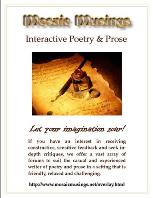  |
 May 23 04, 18:20 May 23 04, 18:20
Post
#1
|
|
|
Group: Administrator Posts: 18,892 Joined: 1-August 03 From: Massachusetts Member No.: 2 Real Name: Lori Kanter Writer of: Poetry & Prose Referred By:Imhotep |
Cause and Effect in Fiction
by Susan J. Letham Writer's question: I was told I need to develop a stronger sense of cause and effect in my fiction. Can you explain cause and effect in simple terms? Response: There are three main areas of cause and effect in a story: character background and motivation, story logic, and micro-level stimulus and response. An overview should make the basic issues clear. Overview of Cause and Effect Before we go into specifics, take a look at a good example of cause and effect in these lines by Madeleine L'engle*: For want of a nail the shoe was lost, For want of a shoe the horse was lost, For want of a horse the rider was lost, For want of a rider the message was lost, For want of the message the battle was lost, For want of the battle the war was lost, For want of the war the kingdom was lost, And all for the want of a horse shoe nail. Fiction writers can learn a lot here. What the poem shows is how one small event (cause) leads to another (effect) and how each effect becomes a cause and leads to a more serious effect than the one before. That's how the cause and effect chain works at story-logic level. Cause and Effect at Story Logic Level When the cause and effect chain is missing links at story- logic level, the story will have gaps. To a reader, the story will seem to be made up of unrelated events. You, the writer, may know what links between your story events are, but the reader will be confused. That's disastrous in genre fiction, where the reader expects linearity and logic. Gaps occur at story-logic level for two main reasons: Reason 1: The author has not plotted the story. Few of us can successfully hold a plot, complete with twists and sub-threads, in memory for the entire time it takes to write a story, but there are always writers who insist on trying. The result is gaps, missing links, and events in the wrong order. The solution, of course, is to plot. Reason 2: The author has failed to consider the reader. The second reason for cause and effect breakdown at story level takes place when writers forget readers' needs. It's not enough for writers to know their stories--writers must understand that they are telling their stories to people with no previous knowledge of the events. Telling a story is like giving how-to-get-there-from-here directions to a stranger. You can't say, "Walk down the High Street, turn into Clark Lane, walk up to Chalmer's, then..." A stranger has no idea what or where these places are. To meet the stranger's needs, you'd have to say: "Turn left from here onto the High Street. Walk towards the clock tower at the end of the street. Halfway between here and the clock tower you'll come to Clark Lane. Turn right into Clark Lane, cross to the left-hand side of the street, then walk up as far as Chalmer's Grocery then..." You have to give your stranger-reader detail and landmarks to work with. Cause and Effect at Character Background Level Everything your characters are and everything they do, they are and do because... In that respect they are just like you. That's why it's vital that you know your characters before you sit down to write. By getting to know your characters and the causes of their wants, needs, and behaviors, you'll be able to let them speak and act in appropriate ways. Cause and Effect at Micro-Stimulus-Response Level Each event in your story must follow from a known stimulus. Characters shouldn't do things for which the reader has no explanation--things that are known only to characters in their minds. Your POV character, especially, should have no secrets from your readers. Readers have an unwritten right to unlimited access to the mind of a POV character and the right to full disclosure of the character's thoughts. Readers should know and understand what the character knows and understands, including the reasons for the character's actions. Make your micro-stimulus and response visible There's a pitfall waiting for the unwary here. Some writers try to have either stimulus or response (or both) take place inside a character's head. As a result, the character's actions, if she acts at all, are unintelligible to the other characters and to the reader. The writer begins to tell rather than show the action. Action needs to be be visible. The causes of the actions must be visible, too. To be visible, they must be external and relate to objects and events that characters and readers can see in the scene. When you show an action, a thought, or a reaction, imagine you're doing so on a stage. Even if a character is alone, have him do something. Use a character thought by all means, but have the character verbalize the thought, take a step forward, pick something up, or complete some other relevant action. Let your motto be: show me! Summary While your story may be clear in your own mind as you write, part of your job as a writer is to make the chain of cause and effect in your story equally logical to your readers. * Excerpt: "For want of a nail," from "A Wind in the Door" by Madeleine L'engle © 2003 Susan J. Letham Susan J. Letham is a British writer, creative writing tutor, and owner of http://www.Inspired2Write.com . Sign up for classes and competent 1-on-1 coaching. Pick up your no-cost subscription to the monthly Inspired2Write Newsletter at: mailto:Inspired2Write_Newsletter-subscribe@yahoogroups.com Permission to reprint this article granted to L Kanter by Susan Letham, 09 March 2004 ·······  ······· ·······"It's a dangerous business, Frodo, going out your door. You step into the Road, and if you don't keep your feet, there is no knowing where you might be swept off to." ~ J.R.R Tolkien, The Lord of the Rings
Collaboration feeds innovation. In the spirit of workshopping, please revisit those threads you've critiqued to see if the author has incorporated your ideas, or requests further feedback from you. In addition, reciprocate with those who've responded to you in kind. "I believe it is the act of remembrance, long after our bones have turned to dust, to be the true essence of an afterlife." ~ Lorraine M. Kanter Nominate a poem for the InterBoard Poetry Competition by taking into careful consideration those poems you feel would best represent Mosaic Musings. For details, click into the IBPC nomination forum. Did that poem just captivate you? Nominate it for the Faery award today! If perfection of form allured your muse, propose the Crown Jewels award. For more information, click here!  "Worry looks around, Sorry looks back, Faith looks up." ~ Early detection can save your life. "Worry looks around, Sorry looks back, Faith looks up." ~ Early detection can save your life.MM Award Winner  |
|
|
|
1 User(s) are reading this topic (1 Guests and 0 Anonymous Users)
0 Members:
  |

|
Lo-Fi Version | Time is now: 26th April 2024 - 01:13 |

















